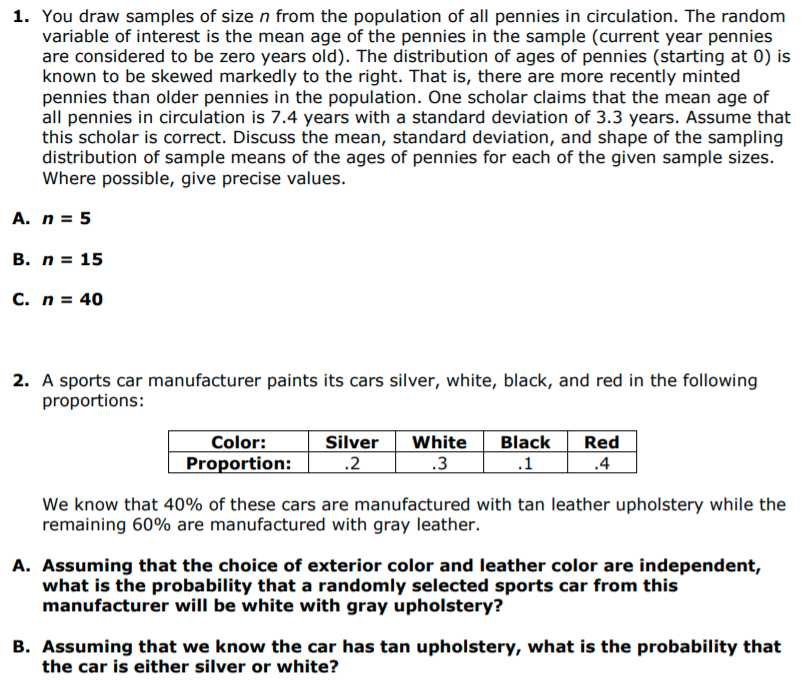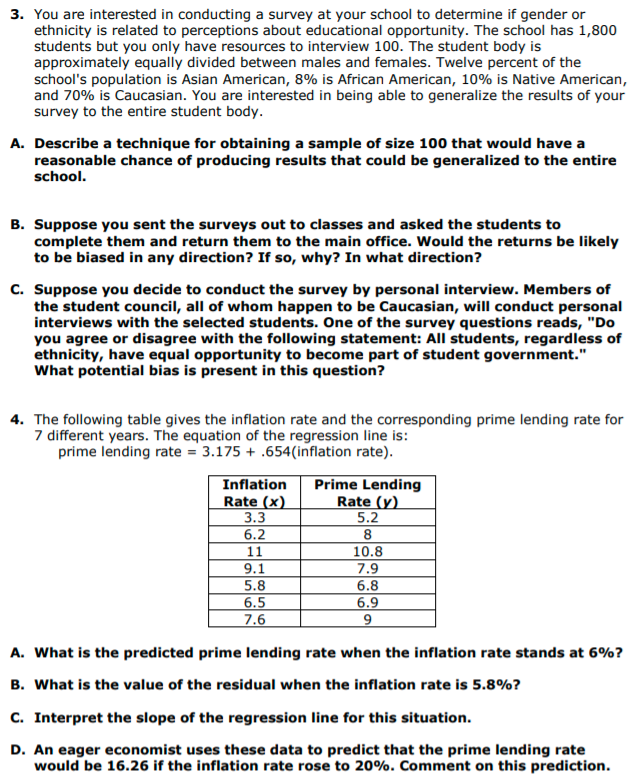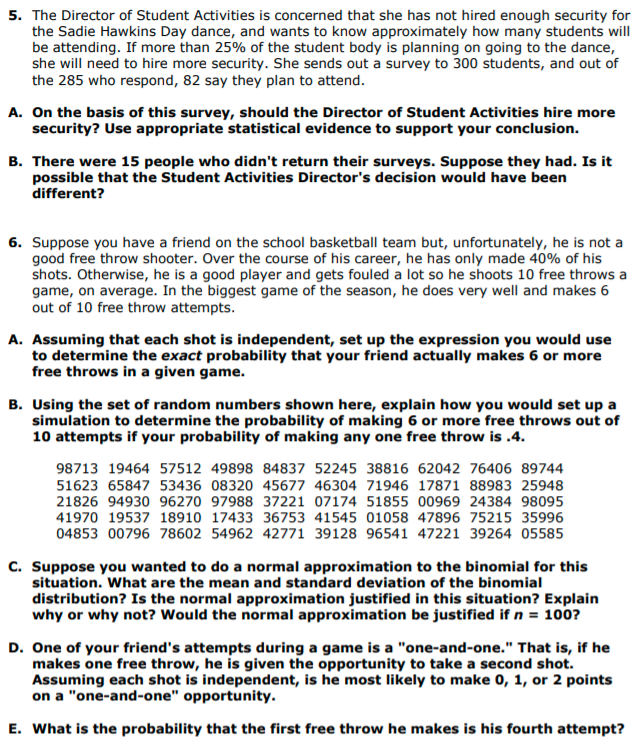Please help with the following FRQ section (will give helpful rating upon completion):
1. You draw samples of size n from the population of all pennies in circulation. The random variable of interest is the mean age of the pennies in the sample (current year pennies are considered to be zero years old). The distribution of ages of pennies (starting at (i) is known to be skewed markedly to the right. That is, there are more recently minted pennies than older pennies in the population. One scholar claims that the mean age of all pennies in circulation is 7.4 years with a standard deviation of 3.3 years. Assume that this scholar is correct. Discuss the mean, standard deviation, and shape of the sampling distribution of sample means of the ages of pennies for each of the given sample sizes. Where possible, give precise values. n=5 n=15 n=40 A sports car manufacturer paints its cars silver, white, black, and red in the following proportions: We know that 40% of these cars are manufactured with tan leather upholstery while the remaining 60% are manufactured with gray leather. Assuming that the choice of exterior color and leather color are independent, what is the probability that a randomly selected sports car from this manufacturer will be white with gray upholstery? Assuming that we know the car has tan upholstery, what is the probability that the car is either silver or white? 4' A. B. C. D. . You are interested in conducting a survey at your school to determine If gender or ethnicity is related to perceptions about educational opportunity. The school has 1,300 students but you only have resources to Interview 100. The student body is approximately equally divided between males and females. Twelve percent of the school's population is Asian American, 8% is African American, 10% is Native American, and 70% Is Caucasian. You are interested in being able to generalize the results of your survey to the entire student body. . Describe a technique for obtaining a sample of size no that would have a reasonable chance of producing results that could be generalized to the entire school. . Suppose you sent HIE surveys out In classes Il'ld asked \"It students t0 oomplete them and return them to the main ofllce. Would the returns be liltelqiI to be biased In any direction? If soIr why? In what dlreotlon? Suppose you decide to oonduet the survey by pmonal interview. Members of the student council, all of whom happen to be Caucasian, will conduct personal interviews with the selected students. One of the survey questions reads, "Do you agree or disagree with the following statement: All students, regardless of ethnicity, have equal opportunity to become part of student government." 1li'li'hat potential bias is present in this question? The following table gives the Ination rate and the carresponding prime lending rate for 7 different years. The equation of the regression line is: prime lending rate - 3.175 + .654tination rate). m Prime Lendlng Bite \"1- E. Whit is the predicted prime lending rite when the Ination rats stands It 6%? What is the value of the rellduel when the Ination rate ls 5.3%? Interpret the slope of the regression line for this situation. An eager economist uses these data to predict that the prime lending rate would be 16.26 If the ination rite rose to 20%. Comment on thls prediction. '1 CI . The Director of Student Activities is concerned that she has not hired enough security for the Sadie Hawkins Day dance, and wants to know approximately how many students will be attending. If more than 25% of the student body is planning on going to the dance, she will need to hire more security. She sends out a survey to 300 students, and out of the 285 who respond, 82 say they plan to attend. (in the basis of this survey, should the Director of Student Activities hire more security? Use appropriate statistical evidence to support your conclusion. . There were 15 people Iwho didn't return their surveys. Suppose they had. Is it possible that the Student Activities Director's decision would have been different? Suppose you have a friend on the school basketball team but, unfortunately, he Is not a good free throw shooter. Over the course of his career, he has only made 40% of his shots. Otherwise, he is a good player and gets fouled a lot so he shoots 10 free throws a game, on average. In the biggest game of the season, he does very well and makes 5 out of 10 free throw attempts. Assuming tl'llt d'l Il'llt l8 ldld't, set up "I. expression m would US. to dlhrmlltl tl'll exec: probability that your friend actually makes 6 or more ff\" throws in I l'iflll game. Using \"II III 0" I'IMOII'I numbers shown him explain hw V0\" Wuld lit up I simulation to determine the problbilihl' of making 6 or more free throws out of 10 attempts if WI" pl'OlIIblllt!' Of Mlhl I!\" one "I. throw l5 .4. 98713 19464 57512 49898 84837 52245 38816 62042 76406 89744 51623 65847 53436 08320 45677 46304 71946 17871 88983 25948 21826 94930 96270 97988 37221 07174 51855 00969 24384 98095 41970 19537 18910 17433 36753 41545 01058 47896 75215 35996 04853 00796 78602 54962 42771 39128 96541 47221 39264 05585 Suppose you wanted to do a normal approximation to the binomial for this litultlon. Whit er. the mean and Itlndlrd deviation of the binomial distribution? Is the normal approximation justltled In this situation? Explain why or why not? would the normal approximation be justied If n - 100? One of your friend's attempts during a game Is a "one-and-one." That Is, II he makes one free throw, he Is given the opportunity to take a second shot. Assuming each shot Is Independent, Is he most likely to make 0, 1, or 2 points on a \"one-and-one'I opportunity. Whit. it till probability Il'llt thl Hm MI litr'l' hl I'I'Ilkll II I'll! Murlh attempt









